Destination Dispatch Elevator Basics
Overview
Destination Dispatch elevator systems benefit passengers, building owners, and design professionals. Increased elevator handling capacity, enhanced tenant satisfaction, and improved energy efficiencies are among the many advantages of elevator destination dispatch management.
Elevators play an increasingly significant role in today’s smart buildings. Their capacity for communication and integration with other building systems—such as heating, ventilation and air conditioning (HVAC), security and fire safety—improves building performance, sustainability, and efficiency. Developments in elevator technology, namely destination dispatching systems that load passengers according to their destination, move people faster, reduce energy consumption, and are customizable in terms of security, function and aesthetics. Moreover, they have added a unique feature to the smart building—that of enhancing the customer’s direct experience by offering intuitive controls that users of mobile technology have come to expect.
Another significant feature is that because destination dispatch systems use advanced software, they can potentially be installed on renovation projects without changing existing elevators. In addition, these latest elevator technologies also have the capacity to impact the design of new construction, a feature that is beginning to be appreciated by the architectural and engineering community. Not only do destination management systems enhance elevator handling capacity—defined as serving more people in less time—they offer design professionals and building owners the flexibility to reduce the size of the building core, potentially adding to usable square footage and thus increasing tenant capacity.
Destination dispatching technology has been the focus of the elevator industry for the past 20 years. First installed in Class A commercial space, it has quickly expanded to residential and mixed-use buildings, especially in urban areas, and has become the standard in most mid-rise and high-rise construction projects. In San Francisco many of the new office high-rise and elevator modernizations employ destination management. All the towers of the World Trade Center in New York City have destination dispatch elevators, a decision made in 2004.
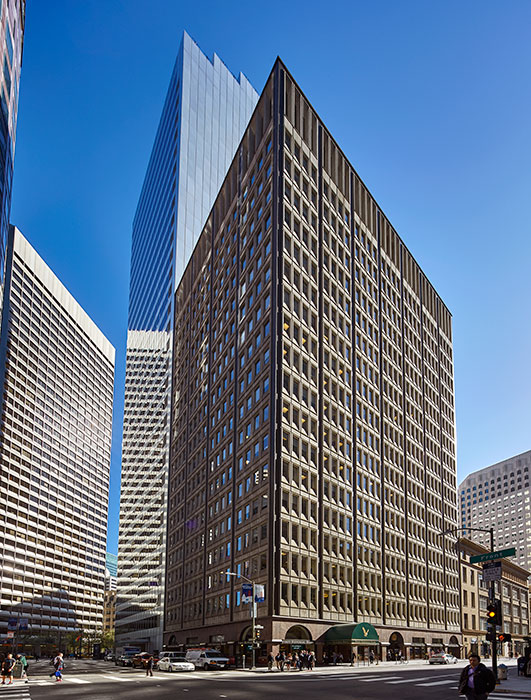
Many San Francisco high-rise buildings are equipped with elevator destination dispatch systems
Benefits of Destination Dispatch (DD)
Following are some of the benefits of DD systems currently on the market:
- For new construction, DD elevator management has the potential for more efficiently configured elevator banks. This can result in smaller elevators, fewer elevators, and smaller and fewer elevator lobbies—that translates into a smaller building core and increased tenant capacity.
- For the renovation of existing buildings, DD systems may be added to existing elevators, depending on their vintage elevator controller. The resulting increase in handling capacity could be achieved without changing the underlying hardware configuration of elevator size, speed, or number.
- Ability to customize the level of security through the use of different access control systems.
- Improved experience for passengers: Shorter wait time, shorter traveling time, reduced car crowding, and fewer stops—especially for passengers on higher floors, such as penthouses.
- Some manufacturing systems provide the ability to provide custom graphics and messaging on input devices.
- Greater control over inter-floor access for both tenants and building users.
- Tenants have the option of expanding their space anywhere in the building because DD systems can manage restricted access to floors that are not contiguous.
- Can service asymmetric floors in buildings where elevators have an uneven number of stops.
- Advanced systems allow for increased communication for building/tenants/passengers with messages concerning such things as safety, corporate information about meetings, and evening time exit destinations.
- Building owners gain from value-added services for tenants and flexibility in the present and future building use.
- Improved information for passengers regarding building entrances and facilities such as food, shopping, spa/fitness, swimming pool.
- Advanced features for people with disabilities.
- Energy savings due to matching elevators to consolidated passenger demand.
- Special features available such as VIP service, pet service, building management, penthouse service, freight/cart service, and swing car.
- Customization for individual passenger preferences.
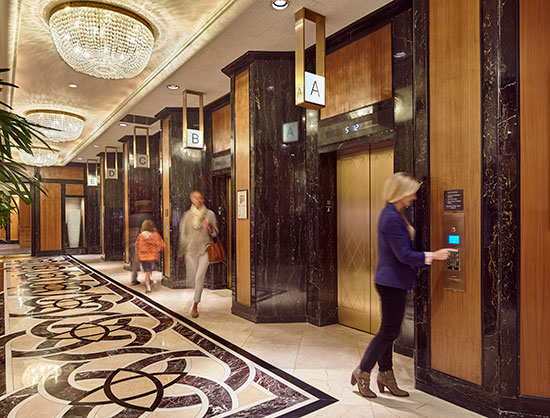
After passengers enter their floor destination, the screen will indicate which elevator to take.
Destination Dispatch (DD) Explained
Destination dispatch (DD) or destination management is the most significant advancement for mid- and high-rise elevators since the automated operation. DD can minimize the number of stops which in turn could significantly reduce car crowding as well as reducing wait time, time to destination, and the number of intermediate stops while increasing handling capacity. Such impact is subject to building population and number of elevators in the building. Elevator passengers are loaded according to their destination rather than by their random arrival in the lobby. Instead of using standard, two-button hall call systems, passengers input the specific floor they want—before they enter the elevator.
For a typical elevator DD system, passengers enter their destination using mechanical keypads, touchpads, or touch screens provided at each floor. The input devices display each digit of the floor number entered by the passenger. These fixtures are either wall or pedestal mounted as selected by the design professional.
Once a destination floor is entered in a fixture, the system acknowledges the destination floor by displaying the requested floor number in the display immediately above the keypad or touchscreen. When the destination floor is entered, the assigned elevator for the passenger is flashed on the display together with a command indicating the direction to the assigned elevator relative to the keypad or touchscreen device. The passenger can then walk to the correct elevator.
When the assigned car arrives the doors are fully opened and the floor assignments are displayed on the destination indicator (annunciator) inside the car.
The latest systems constantly monitor passenger demand to implement the most effective dispatching algorithm at any given moment. They constantly assess real-time passenger origin and destination data in order to assign cars. The dispatching algorithm continuously monitors the levels of elevator traffic during peak and non-peak hours as well as traffic in between floors throughout the day.
Some DD systems account for the walking distance for the elevator passenger from the input device to the assigned car. This calculation is used in dispatching decisions and also to assure the car does not depart before the passenger has entered the car. The walk rate calculation may be customized to account for geographical preferences. The system provides for an extended walk rate calculation for passengers with disabilities (if the handicapped button is pressed) or a specially designated elevator.
Zoned Destination Dispatching
Elevator manufacturers have enhanced DD systems by improving efficiencies and economies of traffic flow and travel time. Zoned destination dispatching (zoned DD), where elevators are assigned to zones or groupings of floors is one such development. By grouping passengers according to their destination and location of stops requested, zoned DD delivers improved management of peak morning up-traffic and two-way peak lunchtime traffic in addition to other features. For example, a conventional DD might assign passengers going to floors five and nine in the same car and passengers going to floors three and eight in the same car so that instead of two cars stopping at four floors, each car will only stop at two floors. But with zoned DD where floors are grouped in segments, passengers are assigned according to their destination and their floor segment. Passengers going to floors three and five would be assigned to the same car, while passengers going to eight and nine would be assigned to another car.
“An evaluation of elevator motion dynamics reveals that when an elevator stops for contiguous floors or nearly contiguous floors, it spends less time in acceleration and deceleration states that if it were making the same number of stops separated by a large number of floors,” says Theresa Muenkel Christy, Engineering Fellow, Otis Elevator Company. “Therefore, elevators spend less time cycling between the lobby and floors above. This reduces round-trip time, allows more round trips, and, ultimately, increases the all-important elevator handling capacity.”
Passengers going to two different segments can be kept separate. This capability could serve two competing companies located in the same building that do not want employees riding together in case sensitive information is discussed.
Zoned DD compared with other elevator systems
Zoned DD systems have a number of advantages over earlier systems.

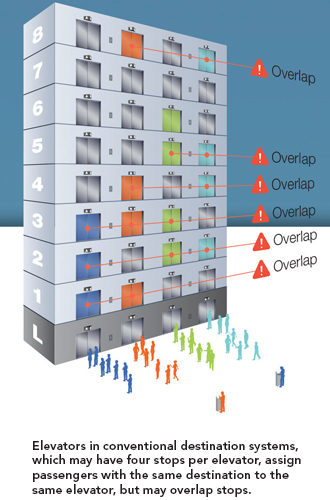
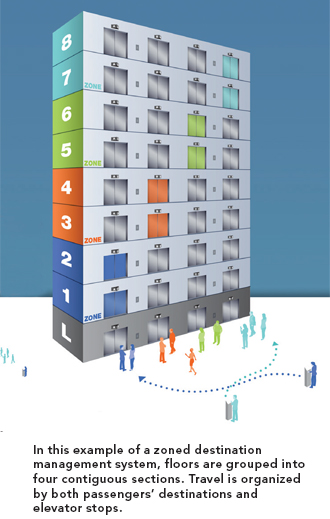
Up/down button system
With a traditional up/down button system, elevators are randomly assigned for passengers. This results in disorganized travel paths since passengers are not grouped by floor. Elevators make many stops per trip. One elevator may stop at widely separated floors or multiple elevators might stop at the same floor. Also passengers can wait a long time for elevators.
Conventional DD systems
A conventional destination management assigns passengers going to the same destination to the same elevator. Elevators stop at fewer floors, but two elevators may still have overlapping stops. Passengers wait less, but can experience a long wait.
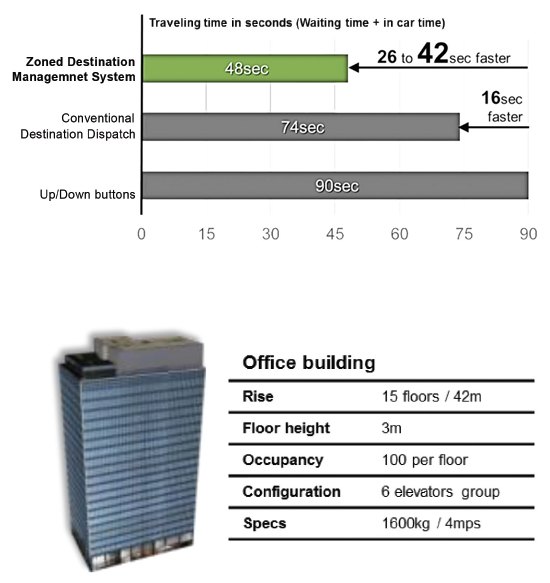
An office building case study found that a zoned DD system reduces travel time (wait time plus car time) getting passengers to their destinations faster than conventional DD and up/down systems.
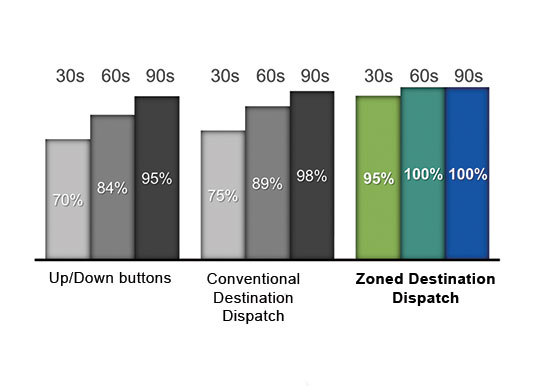
The graph shows the percent of calls answered within 30, 60, and 90 seconds respectively.
Zoned DD
Compared with a conventional DD system, zoned DD systems are faster. One leading elevator manufacturer’s case study found that zoned DD got passengers to their destinations almost 50 percent faster than a conventional DD system.
Reduced wait times
A zoned DD system also improves passenger experience by focusing not only on short wait times but on reducing long wait times. Typically, the loudest passenger complaints are generated by the small percentage waiting longer than 90 seconds for an elevator.
Reduced energy consumption
Zoned DD systems also reduce energy usage by using heavy and light traffic algorithms and grouping floors so that elevators use the least amount of energy. By matching resources to demand, they avoid wasting energy. When the passenger traffic is light, the zoned DD system automatically moves some elevators to standby. During peak periods the system continuously adapts elevator service zones to traffic demands. Algorithms match “up” and “down” stops, the group stops at nearby floors, and create more express runs so that elevators can reach maximum speed and make minimum stops. Fixtures automatically transition to sleep mode when they are not used for a pre-set time interval.
Design professionals should be aware that there are no uniform protocols for comparing energy usage among different manufacturers’ DD systems. Since energy usage of DD controllers and terminals varies according to different products, it is suggested, therefore, that design professionals evaluate the features of the different systems.
Energy-saving features of a zoned DD system can help buildings achieve Building Research Establishment Environmental Assessment Method (BREEAM) certification and Leadership in Energy and Environmental Design (LEED) certification points.
They have also integrated passenger dispatching with security, building systems, and concierge tenant requirements.
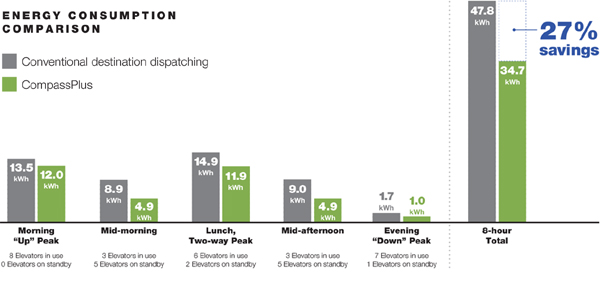
One analysis found that over eight hours, a zoned DD system used 34.7KWh compared with 47.8KWh used by a conventional DD system, a savings of 27 percent.
Zoned DD Passenger and Building Interface
An important feature of a zoned DD passenger/building interface is that it facilitates access for people with disabilities. It can also be personalized to tenants’ needs in the form of a virtual “concierge,” thus potentially providing added value to leases. Building interface can serve asymmetrical floors (elevator groups that have an uneven number of stops) and unique grouping arrangements.
Americans with Disabilities (ADA)
“Elevators can be the most important building system technology for persons with mobility impairments and disabilities in multistory buildings,” says George von Klan, GVK Elevator Consulting Services. Awarded by San Francisco’s Mayor’s Disability Council for his work on elevator technology that is usable by persons with disabilities, von Klan notes that destination dispatch elevators actually provide superior interface and operation for disabled individuals. This includes assignment of the adjacent elevator, additional visual and audio wayfinding, and speech—allowing for different walk speeds, longer door open times, and providing additional space in the elevator car.
But more importantly, von Klan points out, DD systems can recognize individual passengers’ needs and provide customized operation based on their unique requirements.
In the event of a building emergency, a DD system can know the location of a wheelchair-bound person, say, and dispatch an elevator to that floor. At present, there are no such requirements. “If we sincerely intend to improve access,” says von Klan, “there is a clear need for better elevator accessibility standards.”
At present disability standards such as ADA tend to treat people with disabilities the same way. But in reality, a person in a wheelchair who speaks only Spanish has different requirements than someone who has a significant visual impairment or someone who is deaf.
Most DD keypads are typically configured to meet ANSI A17.1 and European EN81-70 accessibility requirements. Touchscreens and touchpads are not described in ANSI A17.1 or EN81, but since the worldwide destination dispatching market is moving toward touchscreen rather than mechanical keypads, manufacturers are incorporating an accessibility button in touchscreens and touchpads.
Concierge Passenger Interface
Some destination systems can serve as a virtual concierge, offering intuitive guidance for passengers. A typical graphics screen choices offers passengers choices that can include a “Welcome” screen for guiding first-time visitors, a “Location” screen that provides a quick access to all main building facilities (for example, entrances, food, shipping, and activities), and a “Building Directory” that has company names as well as their floor numbers so that visitors need not know a company’s floor number. A “Restricted” menu item can handle specific requests and services such as assigning a dedicated car for special groups to keep everyone together, giving priority to VIP passengers (see below), requesting a freight/service elevator for suppliers, or moving to building maintenance mode.
After a destination is placed on the keypad or touchscreen, the concierge screen will orient the passenger as to the direction to reach the allocated elevator. The orientation screen can show a simple arrow and picture of a passenger standing in front of the fixture. Manufacturers usually offer both standard and custom dynamic, and static signage.
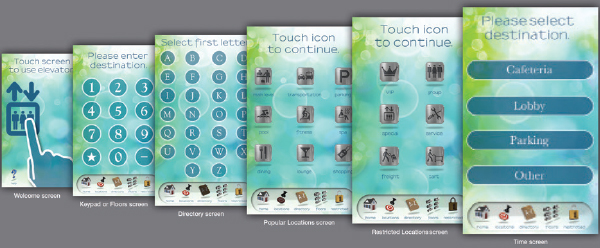
Examples of passenger graphic interface screens that serve as a virtual concierge.

An orientation screen directs a passenger to his/her allocated elevator.
VIP Service
DD can provide exclusive priority service through a dedicated VIP operation activated by security card or code inputted under a restricted menu. An empty car can be sent to a VIP floor and proceed nonstop to its destination. One personalized system schedules a car to wait for four minutes with doors open.
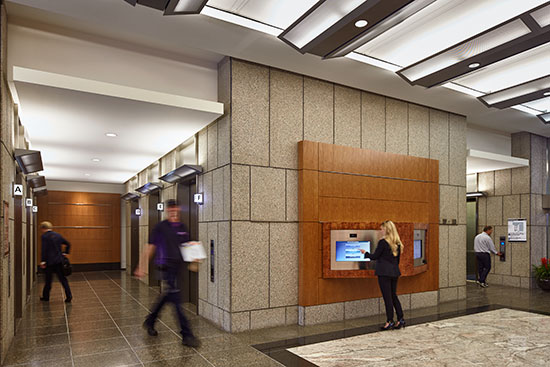
The DD system allows passengers to easily access information such as building facilities and tenant locations.
Asymmetrical floors or “odd floor travel”
The DD system automatically assigns passengers to the correct elevator that serves an “asymmetrical” floor. The system also helps reduce “ghost” calls where passengers place a false call into cars that do not serve the rider’s desired destination floor.
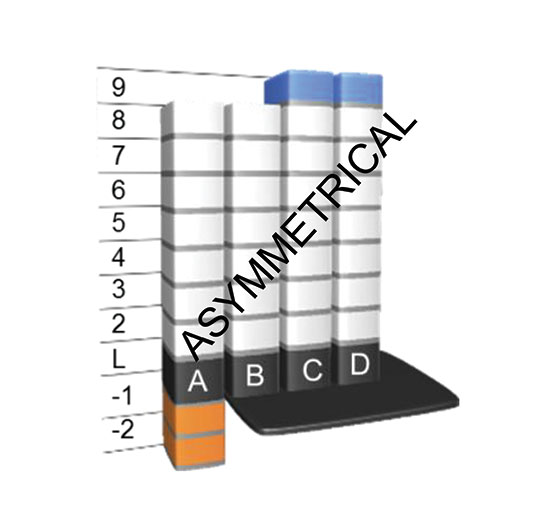
DD dispatch system assigns passengers to elevators that have an uneven number of stops.
Split Group Operation
DD allows a single elevator bank to operate as multiple independent operating groups via split group operation. Once activated, a subset of the cars in the group will behave as an independent group and respond only to destination calls. Building maintenance staff can use assigned elevators without being mixed with other tenant employees. Separation on banks also allows for enhanced building security.
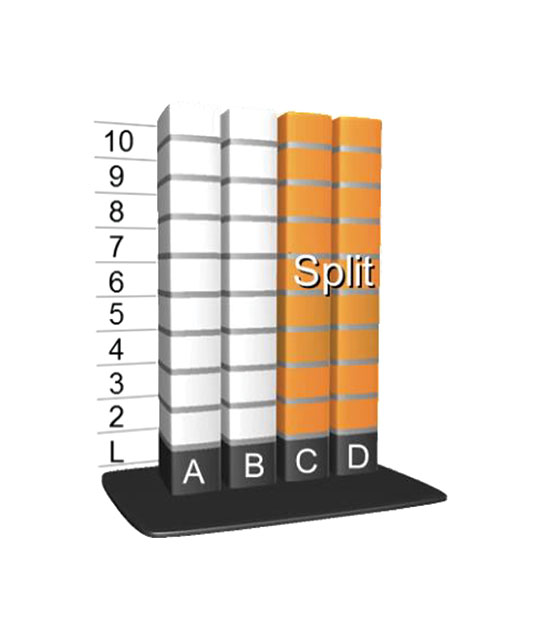
DD systems can split elevator operations so that construction personnel could use Cars A and B, while cars C and D are available for tenants.
Swing Car Operation
DD allows for swing car operation, which assigns cars based on the preferred physical characteristics of certain elevators—or needs of passengers such as dog walkers, housekeeping, or special deliveries. Passengers enter a special reprogrammable code to “capture” the swing car only.
DD Systems with Integrated Security
DD systems offer the ability to customize the level of security interface through the use of numerous different manufacturers’ access control systems. Design professionals should note that an elevator system is subordinate to and serves the access control system. It is essential, therefore, that they consult with the owner and the third-party security integrator as to the most effective choice of different security features that can be integrated with the DD system.
Third-party security system:
The DD system that integrates with a third-party building access control system has flexible security configuration capabilities. For example, DD interface with a third-party access control system could configure an inter-floor matrix dispatch system that would serve the security needs of tenants and the building. In such a matrix system, travel from the unrestricted lobby could be allowed as would be travel within a segment, but travel between segmented floors would be restricted. As segments do not have to be contiguous, passengers going to two different segments can be kept separate. This capability could serve two competing companies located in the same building who do not want employees riding together in case sensitive information is discussed.
Seamless entry:
Seamless entry allows riders to use a security card and automatically have their primary destination entered into the DD system. Note that seamless entry must be part of a third-party access control system integration.

DD can restrict travel between floor segments.
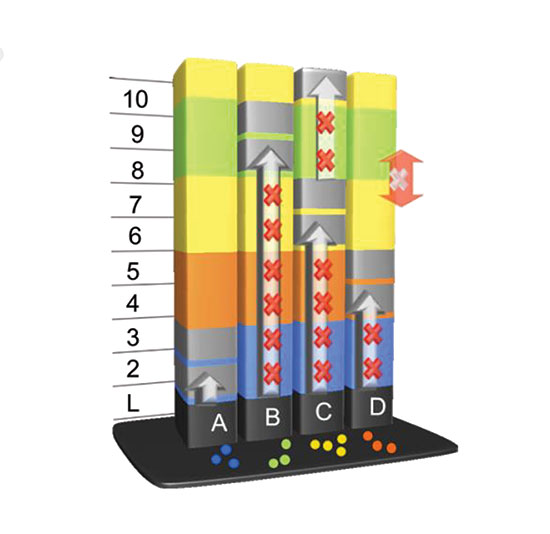
Passengers going to two different segments of restricted floors will not be placed in the same car.
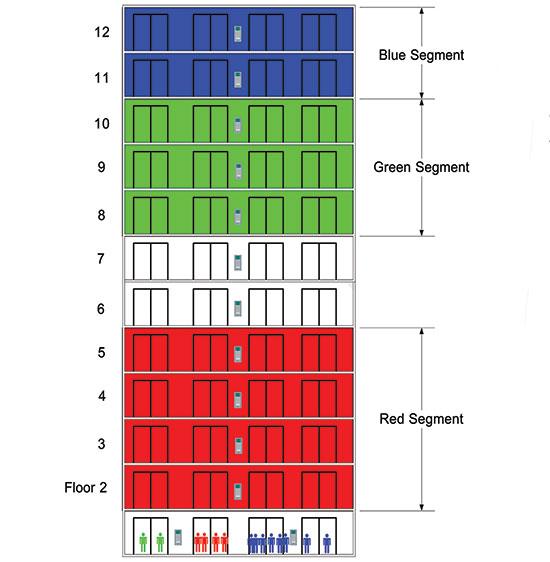
An Example of a restricted interfloor matrix defined by tenants needs. Passengers can travel from the lobby to their designated colored floor segment. Once on a green floor, they can travel to another green floor, but not to a blue or red floor.
Questions to Ask When Evaluating DD Systems
Q. Does the DD system observe and forecast traffic intensity and direction, or only load passengers according to their destination? An “artificial intelligence” system that remembers and forecasts traffic patterns will manage traffic flow more efficiently than a system that begins each elevator loading from scratch.
Q. Does the DD system group passengers going to the same floor and stops?
Q. What are the standard fixture offerings available with DD?
Q. When doing a traffic analysis of a destination system, does the estimate look at handling capacity, final destination, wait time and the number of intermediate stops?
Q. Does the DD system allow for flexible walking distances between the turnstile or entry input fixture and the elevator?
Q. Who is the current security provider and what are the security requirements? What are the current card types being used? Security objectives should be defined upfront, not as an afterthought. How does the DD interface with and support security requirements?
Q. How does the DD system affect elevator energy consumption? There are no uniform protocols for direct comparisons between manufacturers and/or models.
Q. How does the DD system accommodate people with disabilities? Is it compliant with EN81-70 and ICC/ANSI A117.1.2003 ADA codes?
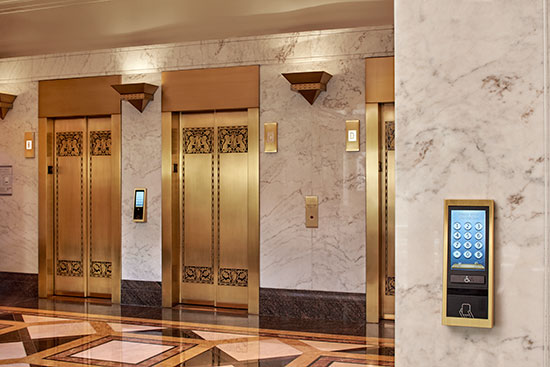
Destination dispatch input devices may be located in the lobby or in the elevator bank.
Destination Dispatching Product Components
A destination dispatching system includes an interconnected computer system comprised of touchscreens, or keypads, computer servers, and switches. The following product components are typically supplied:
Destination Entry Computers
Also named “input devices,” destination entry computers are typically available as keypads, touchpads, and touchscreens. Typically, each input device communicates on an Ethernet communications network, where each keypad or touchscreen is assigned an individual IP address. When security is required, the DD system supplier may provide card radio-frequency identification (RFID) reader devices only.
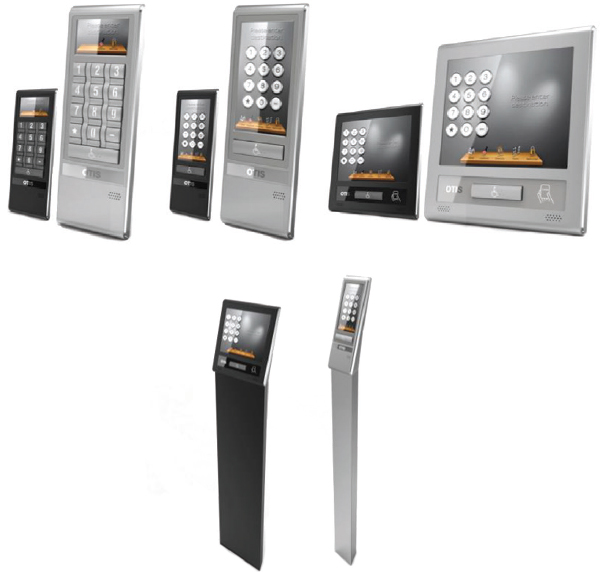
Typical DD system passenger input devices can be customized. These include keypads, touchpads, and touch screens and can be surface or pedestal mounted.
Customer software tool
Some DD system manufacturers may include a software tool so that building managers can create and modify personal graphics and messages. For example, modify an existing concierge template by creating buttons, customizing welcome or help menu items or schedule changes to screens depending on the time of day. Screens may also be programmed for tenant communication, safety messaging, corporate messaging for meetings or advertising.
Car operating panel (COP) and In-car annunciator
Each elevator car is typically furnished with an LED or LCD annunciator panel that will display the floors the elevator is assigned to travel. Also typically available in a full DD system is a car operating panel that includes voice annunciation for passengers with disabilities. Local codes should be checked for requirements. Manufacturers offer a variety of annunciator models.

Examples of LCD (left) and segmented LED in-car annunciator models.
Building Applications for DD Systems
DD technology is increasingly being installed in all types of mid- and high-rise buildings. Most major elevator manufacturers offer simulation performance metrics of different dispatching systems that can serve as helpful comparison data. Most manufacturers also offer traffic analysis reports that can be used to determine the potential benefits of a DD system and if it is a right fit for the project—or even help solve building design challenges. The table of Recommended Performance Values provides a useful baseline for destination dispatch metrics.

Average Time To Destination (ATTD) is the time arriving at the elevator system to the time the passenger reaches his or her destination floor.
“To achieve the full benefits of DD requires additional expertise, planning, and coordination during elevator and building system design. This includes elevator quantities, grouping, and arrangement, as well as keypad quantities and locations, as well as access control interface, inter-floor traffic control and configuring special building and tenant features,” says von Klan, who has consulted on numerous DD systems in new and existing building. In general, the bigger and taller the building, the greater the opportunities for performance, cost, and core efficiency gains with DD. But von Klan has also designed DD systems in buildings with only two elevators, such as in a group where both elevators do not serve the same floors. Indeed, one of the biggest areas of untapped potential with DD systems is “intra-group” asymmetry. With a DD system, all elevators within the group do not need to serve all the same floors, nor do they necessarily need to be the same size or speed (whereas a conventional “two button” elevator system typically requires all passenger elevators within the group to serve all the same floors).
Other benefits of DD have yet to be fully explored. For example, while it is generally accepted that DD elevators reduce travel time, it is often not fully understood that the passengers who benefit the most from the reduced trip time are those travelling to the top floors of the elevator group. This is a significant benefit not just in office buildings, but particularly in high-rise hotels and apartment buildings where there is often only one elevator group serving many floors—and tenants, guests, or residents at the top of the building often pay the highest rent.
Hospitals would be very well served with DD systems, especially for service elevators moving bed lifts and patients on gurneys. An elevator already carrying a gurney or a person in a wheelchair would not stop for another gurney or wheelchair. Additionally, some manufacturers incorporate a feature known as Code Blue that enables critical medical personnel to capture an elevator and reach patients during an emergency situation.
Conclusion
Destination dispatching systems increase elevator handling capacity, decrease energy usage, move people faster, and enhance customer experience. Advanced systems that manage passenger travel according to individual destinations and grouping or zoning of floors can be programmed for security requirements and customized features such as concierge passenger interface. They may be added to existing elevator systems in modernization projects and in new construction where they can save space, thereby allowing more rentable area. Elevator destination dispatching systems have become the standard and are recognized as the future for mid- and high-rise construction projects.
Otis Elevator Company, part of United Technologies Corp. (NYSE: UTX), is the world's largest manufacturer and maintainer of people-moving products, including elevators, escalators and moving walkways. It has been a constant, reliable brand for more than 160 years. www.otis.com